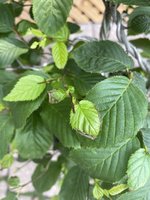I’m wondering if anyone has the answer to this. I’ve noticed some new growth on my Hornbeam has started to develop this brown edges to them. The edges while brown, are not crispy or dry when they first develop.
My tree is kept in the shade for as long as possible throughout the day, but gets sun from around 4:30 to 6:30 each day. the soil is kept moist, and watered when it starts to dry out a bit. I thought the tree may have a fungus issue so I sprayed it with fungicide late one evening during dusk a few days back.
Does this look like sunburn or some other issue to do with fungus or roots?
My tree is kept in the shade for as long as possible throughout the day, but gets sun from around 4:30 to 6:30 each day. the soil is kept moist, and watered when it starts to dry out a bit. I thought the tree may have a fungus issue so I sprayed it with fungicide late one evening during dusk a few days back.
Does this look like sunburn or some other issue to do with fungus or roots?




